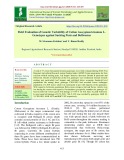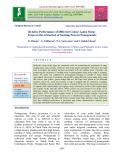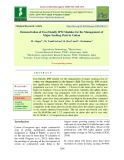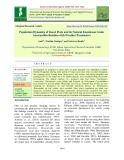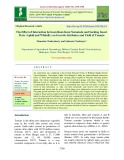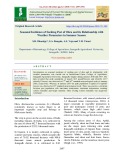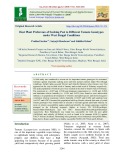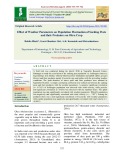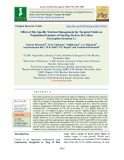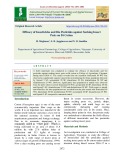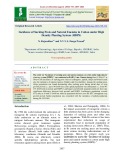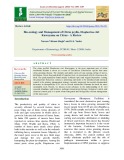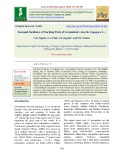
Sucking pest population
-
During the investigation sucking pest viz; white fly and jassid were appeared in 33 standard meteorological week and maximum population of whitefly (0.60 per plant) and jassid (0.40 per plant) was recorded in 37th SMW. Correlation with sucking pest (whitefly and jassid) population and meteorological parameters was found positive non significant association with evening relative humidity and minimum temperature but negative correlation with maximum temperature, morning relative humidity and rainfall.
 8p
8p  caygaocaolon11
caygaocaolon11
 21-04-2021
21-04-2021
 11
11
 1
1
 Download
Download
-
Field studies were undertaken at Agricultural Research Farm, Darsi, Andhra Pradesh to study the comparative bio-efficacy of cow based (dung and urine) fermented organic products viz., neemastra, brahmastra and agniastra at 20% along with Neem Seed Kernel Extract (NSKE) 5 % against the major pests of castor and their safety to natural enemies during 2016-17. NSKE 5% recorded least no. of mean larval population of Achaea janata (1.06 plant-1 )...
 9p
9p  chauchaungayxua10
chauchaungayxua10
 19-03-2021
19-03-2021
 21
21
 1
1
 Download
Download
-
A total of 27 cotton Gossypium hirsutum genotypes were field evaluated during 2018-19 at Regional Agricultural Research station Nandyal under AICRP-Cotton programme for their reaction towards sucking pests, leaf hopper Amrasca devastans Distant in particular and bollworms. Results revealed that all the test genotypes were moderately tolerant towards sucking pest particularly leaf hoppers and exhibited below economic threshold level populations but among them, genotype CNH-2052 had recorded lowest leafhopper population of 2.
 7p
7p  chauchaungayxua11
chauchaungayxua11
 23-03-2021
23-03-2021
 8
8
 1
1
 Download
Download
-
Different colour sticky traps are commonly used for monitoring the population of many sucking pests such as thrips, whiteflies, leaf miner adults and aphids. They have also been used to monitor the natural enemies associated with the sucking pests. Presently, the monitoring the incidence of sucking pests in pomegranate using sticky traps is wanting. Hence, the study was conducted in pomegranate planting at orchard of Tamil Nadu Agricultural University, Coimbatore during 2016, using different colour laden sticky traps like yellow, pale yellow, green, orange and red.
 8p
8p  nguaconbaynhay10
nguaconbaynhay10
 22-01-2021
22-01-2021
 10
10
 2
2
 Download
Download
-
Survey was conducted in major pomegranate growing area of Tharad, Deodar and Bhabhar talukas of Banaskantha district in Gujarat during mrig bahar season by using of multistage ramdom methods. Population of anar butterfly, fruit suckin moth, thrips, whitefly and aphid was observed during the period of study.
 4p
4p  trinhthamhodang9
trinhthamhodang9
 16-12-2020
16-12-2020
 17
17
 2
2
 Download
Download
-
Eco-friendly IPM module for the management of major sucking pests of cotton was demonstrated in the farmer‟s field. Eco-friendly IPM module has significantly reduced the sucking pests population. The leafhoppers population was low (1.5 number / 3 leaves) in the demo plots and it was high (4.2 numbers/ 3 leaves) in the check plots. Similarly the aphids, thrips, whitefly and mealy bug population were low in the demo plots when compared to the check plots.
 6p
6p  caygaocaolon7
caygaocaolon7
 18-09-2020
18-09-2020
 9
9
 0
0
 Download
Download
-
Investigation on incidence of insect pests on grain amaranth was undertaken at MRS, Hebbal, Bengaluru. During study period, 19 insect pests have been recorded throughout the cropping period. Among these, Stem weevil, leaf webber, leaf eating caterpillar and sucking pests are the major one. Five natural enemies were recorded during the present investigation.
 9p
9p  caygaocaolon7
caygaocaolon7
 18-09-2020
18-09-2020
 10
10
 1
1
 Download
Download
-
The study revealed that the observations taken for plant growth attributes and yield were comparatively higher in the plots with no pest infestation and were the lowest in the plants subjected to infestation by both root knot nematode and sucking insects. The interaction effect between different fertilizer regimes and different pest infestation was significant for all plant growth attributes and yield. The populations of these pests were lower in plants infested by both as compared to the plants subjected to sole infestation of these pests.
 9p
9p  nguaconbaynhay7
nguaconbaynhay7
 15-08-2020
15-08-2020
 6
6
 1
1
 Download
Download
-
Population dynamics of sucking pests of sesame viz. thrips, whitefly, leaf hoppers and aphids were studied. Correlation between the pest population and weather parameters was analyzed and regression equations were developed. Incidence of aphids, leaf hoppers and thrips on sesame crop during kharif season has started on 25th SMW.
 11p
11p  nguaconbaynhay7
nguaconbaynhay7
 15-08-2020
15-08-2020
 17
17
 1
1
 Download
Download
-
Cyantraniliprole 10% OD at 90 g a.i.ha-1 was significantly effective when sprayed twice at 15 days interval, minimized the sucking pests population and increased cotton kapas yield. Cyantraniliprole 10% OD treatments at 90, 180 and 320 g a.i. ha-1 concentrations had not caused any phytotoxic effects like injury to leaf tip, leaf surface, wilting, vein clearing, necrosis, epinasty and hyponasty. Cyantraniliprole 10% (w/v) OD showed the least effect against the spiders.
 13p
13p  nguaconbaynhay6
nguaconbaynhay6
 24-06-2020
24-06-2020
 9
9
 1
1
 Download
Download
-
Investigation on seasonal incidence of sucking pest of okra and its relationship with weather parameters was carried out at Instructional Farm, College of Agriculture, Junagadh Agricultural University, Junagadh, Gujarat during summer 2016 and 2017. The data revealed that peak population of jassid (16.1 jassid/3leaves) and whitefly (15.7 whitefly/3 leaves) was observed at 17th and 16th standard meteorological week of summer 2016, respectively. Whereas, in summer 2017 the peak population of aphid (17.8 aphid/3 leaves) was observed at 16th standard meteorological week.
 8p
8p  gaocaolon5
gaocaolon5
 14-06-2020
14-06-2020
 11
11
 1
1
 Download
Download
-
A field study was conducted to screen out six important tomato genotypes for resistance/ tolerance against important sucking pests and their natural enemies under West Bengal conditions. Aphid (Aphis gossypii Glover) and whitefly (Bemisia tabaci Genn.) were first appeared on the crop in third week of January and second week of February respectively. The peak populations of both the pest were reached in the third to fourth week of February.
 9p
9p  gaocaolon5
gaocaolon5
 14-06-2020
14-06-2020
 16
16
 2
2
 Download
Download
-
Seasonal incidence of different sucking pests of chilli viz., thrips (Scirtothrips dorsalis Hood), mites (Polyphagotarsonemus latus Banks), Aphid (Aphis gossypii Glov.), Whitefly (Bemesia tabaci Genn.) and Jassids (Amrsca bigutula bigutula) and natural enemies like Coccinellids and spiders were worked out in the present study during 2016 at District Seed Farm (AB Block) of Bidhan Chandra Krishi Viswavidyalaya located at Kalyani, Nadia, West Bengal. Peak population of thrips was recorded to be in 18th standard week i.e. 12.
 13p
13p  angicungduoc5
angicungduoc5
 12-06-2020
12-06-2020
 20
20
 0
0
 Download
Download
-
A field trial was conducted during the kharif, 2016 at Vegetable Research Centre, Pantnagar to study the correlation of the sucking pest population viz. leafhopper (Amrasca bigutullabigu tulla Ishida), whitefly (Bemisiatabaci Gennadius) and aphids (Aphis gossypii Glover) and their predators mainly Coccinella spp. and spiders with the prevailing weather conditions. The peak densities of insect pests and their predators were attained in September-October.
 6p
6p  trinhthamhodang1213
trinhthamhodang1213
 29-05-2020
29-05-2020
 6
6
 0
0
 Download
Download
-
The field experiment on cotton productivity and leaf reddening as influenced by nutrition management for targeted yield was conducted during growing seasons of 2014-15 and 2015-16 at College of Agriculture Farm, Raichur, Karnataka on medium deep black soil under irrigation.
 6p
6p  trinhthamhodang1213
trinhthamhodang1213
 27-05-2020
27-05-2020
 13
13
 0
0
 Download
Download
-
A field experiment was conducted to evaluate the efficacy of insecticides and bio pesticides against sucking insect pests on Bt cotton at College of Agriculture, Vijayapur during kharif-2016-17. The results revealed that the treatment flonicamid 50 WG was observed as significantly superior insecticide in minimizing the thrips population followed by fipronil 5 SC, acetamiprid 20 SP, dinotefuron 20 SG, diafenthiuron 50 WP and thiamethoxam 25 WG.
 12p
12p  chauchaungayxua5
chauchaungayxua5
 08-05-2020
08-05-2020
 13
13
 0
0
 Download
Download
-
The study on “Incidence of sucking pests and natural enemies in cotton under high density planting system (HDPS)” was conducted at RARS, Lam, Guntur during kharif, 2016-17 to observe the incidence of sucking pests such as leafhoppers, aphids, thrips and whitefly and also the incidence of natural enemies (Spiders and Coccinellids). Among the sucking pests thrips population was found dominating other sucking pests during initial days of crop growth period i.e., up to 90 DAS there after aphid population was dominated i.e., from 90- 135 DAS both in normal and HDPS.
 8p
8p  kequaidan4
kequaidan4
 05-05-2020
05-05-2020
 11
11
 1
1
 Download
Download
-
The citrus psyllid, Diaphorina citri Kuwayama, is the most important pest of citrus worldwide because it serves as a vector of Candidatus Liberibacter species that cause citrus greening disease. The nymphs and adults suck cell sap causing curling of leaves, defoliation, flower drop and death of branches from t to downwards which is known as die back. The peak population found usually in March-April and August-September.
 17p
17p  nguathienthan4
nguathienthan4
 21-04-2020
21-04-2020
 6
6
 2
2
 Download
Download
-
The main aim of the study was to reduce the maximum use of pesticides, these pesticides increases pest resurgence, environmental pollution and toxic residue in food. Efforts were being made to encourage those pest management practices which are ecofriendly. Pooled mean of both the years during 2016 and 2017 revealed that minimum population of leafhopper nymphs was recorded in cotton intercropped with bajra as border crop (2.47 nymphs/leaf) and maximum population was recorded in sole cotton (3.54 nymphs/leaf).
 9p
9p  nguathienthan4
nguathienthan4
 18-04-2020
18-04-2020
 18
18
 1
1
 Download
Download
-
Seasonal Incidence of sucking pests of groundnut (Arachis hypogaea L.)” was studied during July to October 2016, at Research farm, College of agriculture, Kolhapur. Groundnut crop was infested by Jassid (Empoascakerri Pruthi), Thrips (Scirtotharips dorsalis Hood). The study revealed that the incidence of jassid started in 2nd week of August; and thrips 1st week of August. The population of Jassid, Empoascakerri (Pruthi) the population steadily increased and reached to its peak in the 35th MW corresponding to September 1st week 3.06 jassids/3 leaves.
 4p
4p  caygaocaolon4
caygaocaolon4
 01-04-2020
01-04-2020
 10
10
 1
1
 Download
Download
CHỦ ĐỀ BẠN MUỐN TÌM











